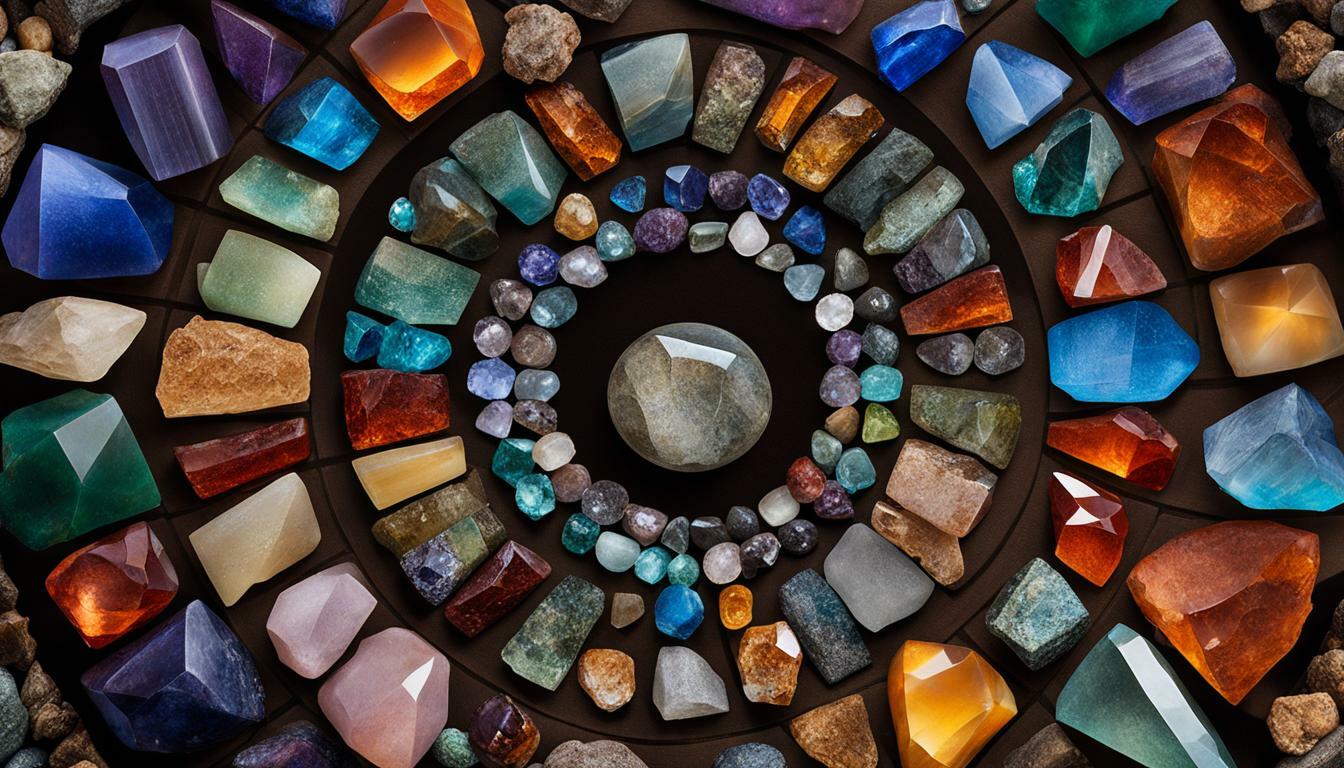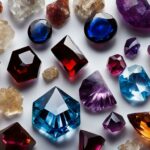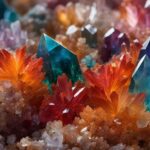Unlock the hidden world within rocks by learning how to identify crystals and stones. The process of crystal identification involves classifying crystals based on their physical and chemical properties, such as color, streak, luster, hardness, and crystal shape. By understanding these properties, you can delve into the secrets that crystals hold and embrace your inner geologist.
Key Takeaways:
- Crystal identification involves classifying crystals based on their physical and chemical properties.
- Methods such as the Mohs hardness scale, acid tests, magnetism tests, and tenacity tests can be used for crystal identification.
- Mobile apps like Stone Crystal Identification App, Geology Toolkit, and Crystalyze: Crystals & Stone can assist in crystal identification.
- Color plays a significant role in crystal identification, with different colors having different meanings and associations.
- Crystals can also be identified by their unique shapes and structures.
- Some crystals are associated with specific chakras or astrological signs, providing further guidance in identification and working with crystals.
Now that you have a basic understanding of crystal identification, let’s explore the various methods and resources in detail to help you unlock the full potential of these mesmerizing stones.
Using Physical and Chemical Properties for Crystal Identification
There are various physical and chemical properties that can be utilized to identify crystals and stones. By understanding these properties, you can unlock the secrets of these beautiful natural formations. One of the most commonly used methods for crystal identification is the Mohs hardness scale. This scale measures the hardness of a mineral on a scale from 1 to 10, with 1 being the softest (talc) and 10 being the hardest (diamond). By testing the hardness of a crystal or stone, you can determine its place on the scale and narrow down your options for identification.
In addition to hardness, conducting acid tests can also be helpful in identifying crystals. Each mineral has a unique reaction to different types of acid, which can provide clues about its composition. By carefully observing the response of a crystal to acid, you can gather valuable information that can aid in its identification. Another method is conducting magnetism tests, as some minerals are naturally magnetic while others are not. By using a strong magnet, you can determine if a crystal or stone exhibits magnetic properties.
Tenacity tests are another way to identify crystals and stones. Tenacity refers to a mineral’s resistance to breaking, bending, or deforming. There are several terms used to describe tenacity, such as brittle, malleable, sectile, ductile, and flexible. By examining how a crystal or stone reacts to physical stress, you can gain further insight into its properties and narrow down your identification options.
Using Physical and Chemical Properties for Crystal Identification
In addition to the methods mentioned above, color and shape can also play a significant role in crystal identification. Different colors have different meanings and associations, and crystals can exhibit a wide range of shades and hues. By considering the color of a crystal or stone, you can further narrow down your identification possibilities. Additionally, crystals have distinct shapes and structures that can aid in their identification. Crystals can display a variety of forms, such as prisms, pyramids, cubes, and more. By studying the shape and structure of a crystal, you can gather valuable information to help with its identification.
| Crystal Identification Apps | Description |
|---|---|
| Stone Crystal Identification App | This app provides a comprehensive guide to identifying various types of crystals and stones, including detailed descriptions and images. |
| Geology Toolkit | Geology Toolkit offers a range of tools for geologists and crystal enthusiasts, including an identification guide and information about geological processes. |
| Geology Toolkit Premium | Geology Toolkit Premium is an enhanced version of the Geology Toolkit app, featuring additional resources and an ad-free experience. |
| Geology of Rocks – Handbook of Rocks | This app provides a comprehensive reference guide to rocks, minerals, and crystals, including information on their properties and identification. |
| Minerals Guide: Rocks, Crystals, and Gemstones | This app offers a comprehensive guide to minerals, crystals, and gemstones, with detailed descriptions and images for easy identification. |
| Crystalyze: Crystals & Stone | Crystalyze is a mobile app that allows users to identify crystals and stones using various identification methods and a large database of minerals. |
| The Magic Of Crystal | The Magic Of Crystal app offers a wealth of information about crystals, including an identification guide, healing properties, and more. |
By utilizing these methods and resources, you can enhance your crystal identification skills and deepen your connection with these fascinating geological treasures. Remember to consider the physical and chemical properties, color, shape, and even the metaphysical associations of crystals when identifying them. Embrace your inner geologist and explore the unique energies that crystals and stones possess.
Utilizing Color and Shape in Crystal Identification
Color and shape are important factors that can assist in the identification of crystals and stones. The vibrant hues and unique physical forms of crystals can provide valuable clues about their composition and properties. By understanding the significance of color and shape, you can enhance your ability to identify and appreciate these mesmerizing treasures of the Earth.
When it comes to color, different crystals exhibit a wide range of hues, from translucent and colorless to vivid and multi-colored. The color of a crystal can be influenced by impurities present in its chemical composition. For instance, amethyst crystals derive their purple hue from iron impurities, while rose quartz showcases a delicate pink color due to trace amounts of titanium or manganese. Considering the color of a crystal can help narrow down your options and guide you towards its correct identification.
The shape of a crystal is another important characteristic to consider during the identification process. Crystals possess unique geometric arrangements of atoms, resulting in distinct crystal shapes and structures. Some common crystal shapes include cubic, prismatic, tabular, and pyramidal. By observing the shape of a crystal, you can gain insights into its crystal system, symmetry, and atomic arrangement. This information can be crucial in correctly identifying crystals, as different minerals tend to have specific crystal shapes associated with them.
As you immerse yourself in the world of crystal identification, remember that color and shape are just a starting point. Consider leveraging additional properties such as hardness, luster, transparency, and even the presence of striations or inclusions. By combining multiple identification techniques, including color and shape analysis, you can confidently unlock the secrets of crystals and stones, discovering their unique energies and embracing the wonders of the Earth.
Table: Common Crystal Shapes and Their Associated Minerals
| Crystal Shape | Associated Minerals |
|---|---|
| Cubic | Pyrite, Halite, Fluorite |
| Prismatic | Quartz, Tourmaline, Beryl |
| Tabular | Barite, Gypsum, Celestite |
| Pyramidal | Amethyst, Garnet, Mica |
Exploring Additional Methods and Resources for Crystal Identification
Apart from traditional methods, there are other tools and resources available to aid in crystal identification. These modern resources can enhance your crystal identification journey and make it more convenient and accessible. One such resource is the use of mobile apps specifically designed for crystal identification. These apps provide comprehensive databases and detailed information about various crystals and their properties.
Some popular crystal identification apps include Stone Crystal Identification App, Geology Toolkit, Geology Toolkit Premium, Geology of Rocks – Handbook of Rocks, Minerals Guide: Rocks, Crystals, and Gemstones, Crystalyze: Crystals & Stone, and The Magic Of Crystal. These apps allow you to search for crystals based on their color, shape, and other properties, making it easier to identify and learn about specific crystals.
In addition to mobile apps, another useful resource for crystal identification is the association of crystals with specific chakras and astrological signs. Crystals are believed to have unique energies that can align with and support specific chakras or astrological signs. By understanding the connection between crystals and these energy centers, you can narrow down your options and choose crystals that resonate with your intentions or needs.
Table: Crystal Identification Resources
| Resource | Description |
|---|---|
| Stone Crystal Identification App | A mobile app with a vast database of crystals and their properties, allowing users to search for crystals based on various criteria. |
| Geology Toolkit | An app that provides information and tools for identifying rocks, minerals, and crystals, including a mineral identification key. |
| Geology Toolkit Premium | A premium version of the Geology Toolkit app that offers additional features and a larger database of crystals and minerals. |
| Geology of Rocks – Handbook of Rocks | A comprehensive guidebook that covers various types of rocks, minerals, and crystals, including their identification and properties. |
| Minerals Guide: Rocks, Crystals, and Gemstones | An app that provides information on minerals, crystals, and gemstones, including their identification, formation, and uses. |
| Crystalyze: Crystals & Stone | An app that offers a crystal identification tool, crystal meanings, and information on crystal healing. |
| The Magic Of Crystal | An app that provides information on crystals, their properties, and how to use them for self-healing, meditation, and manifestation. |
By utilizing these additional methods and resources, you can expand your knowledge and understanding of crystal identification. Whether you prefer the convenience of mobile apps or the guidance of chakra and astrological associations, these tools can support you on your crystal identification journey, helping you connect with the unique energies and beauty of crystals.
Conclusion
Identifying crystals and stones allows us to uncover their hidden properties and harness their energies for personal growth and well-being. By understanding the physical and chemical properties of crystals, we can embark on a journey of exploration and connection with the Earth.
One of the key methods for crystal identification is through the use of physical and chemical tests. The Mohs hardness scale, acid tests, magnetism tests, and tenacity tests can provide valuable insights into the composition and characteristics of crystals. These tests, when conducted carefully, can help us identify and differentiate between different types of crystals and stones.
Color and shape also play essential roles in crystal identification. Different colors have distinct meanings and associations, which can aid in narrowing down options and guiding the identification process. Additionally, crystals have unique shapes and structures that can provide valuable clues about their identities.
In this digital age, technology can be a valuable tool in crystal identification. Mobile apps specifically designed for crystal identification, such as Stone Crystal Identification App, Geology Toolkit, Geology Toolkit Premium, Geology of Rocks – Handbook of Rocks, Minerals Guide: Rocks, Crystals, and Gemstones, Crystalyze: Crystals & Stone, and The Magic Of Crystal, provide a convenient and accessible way to enhance our understanding of crystals.
Furthermore, crystals can also be associated with specific chakras and astrological signs. This additional layer of guidance can assist in identifying and working with crystals that align with our personal energies and intentions.
By delving into the world of crystal identification, we can embark on a journey of self-discovery and spiritual growth. So, why not take the first step and begin exploring the fascinating realm of crystals and stones?
Why is it important to know how to display crystals at work when identifying them?
When identifying crystals, displaying crystals at work is essential. It allows you to observe their unique properties and characteristics, aiding in accurate identification. By properly showcasing crystals, you can analyze their color, shape, transparency, and inclusions. This knowledge helps differentiate them from similar-looking stones, ensuring precise classifications and enhancing your understanding of their metaphysical properties.
FAQ
Q: How do I identify crystals and stones?
A: Crystal identification involves classifying crystals based on their physical and chemical properties, such as color, streak, luster, hardness, and crystal shape. There are various methods to identify crystals, including using the Mohs hardness scale, conducting acid tests, magnetism tests, and tenacity tests. Mobile apps, such as Stone Crystal Identification App and Geology Toolkit, can also assist in crystal identification. Additionally, colors, shapes, and associations with chakras or astrological signs can aid in narrowing down options and guiding the identification process.
Q: What physical and chemical properties can be used for crystal identification?
A: Several physical and chemical properties can be utilized in crystal identification, including color, streak, luster, hardness, and crystal shape. These properties can be assessed through methods such as the Mohs hardness scale, acid tests, magnetism tests, and tenacity tests. Understanding these properties can provide valuable insights into the nature of crystals and stones.
Q: How can color and shape help in identifying crystals and stones?
A: Color and shape play a significant role in the identification of crystals and stones. Different colors have different meanings and associations, which can help narrow down options and guide the identification process. Crystals also have distinct shapes and structures, and recognizing these characteristics can contribute to their identification.
Q: Are there any additional methods or resources for crystal identification?
A: Yes, there are additional methods and resources for crystal identification. Mobile apps, such as Stone Crystal Identification App, Geology Toolkit, and Geology of Rocks, can assist in identifying crystals. Additionally, crystals can be associated with specific chakras or astrological signs, providing further guidance in their identification and utilization.








